A good tuner pedal is one of the most important pieces of gear you can invest in. Tuners are certainly overlooked and underrated tools, that are not only useful for accurate tuning, but also for setting up your instrument the right way.
I’ve had bandmates show up with all kinds of various tuning implements. Needless to say, there are plenty of sub-par options when compared to a quality pedal tuner.
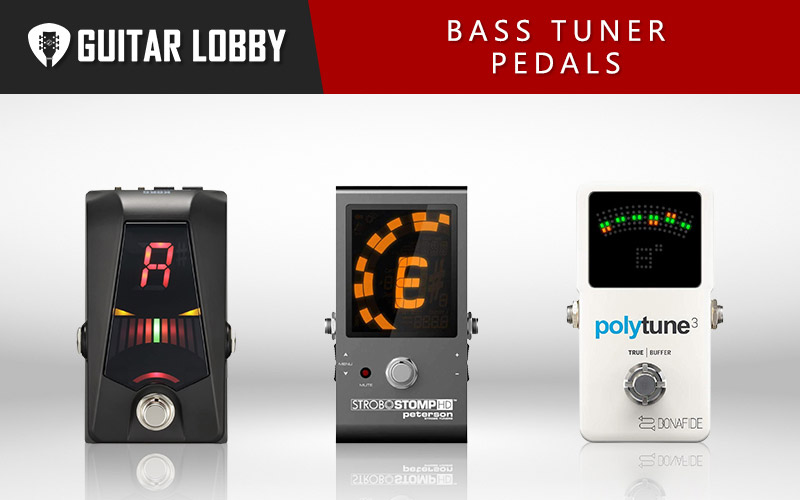
Dozens of pedals have been released in recent years, with different accuracy ratings, and at different price points. To aid you in your search for the right tuner pedal, we’ve gathered up and reviewed all the best bass tuner pedals available and picked out our favorites.
If you want to refresh your knowledge or to dig deeper into the world of tuners, check out our tuner pedal buying at the bottom of the page, where we’ll fill you in about their distinguishing features, what to look out for, and give you a few useful tips on how to use them for the best results.
| Name of Product | Image of Product | Description | Price Range | Full Review |
|---|---|---|---|---|
| 1. TC Electronic PolyTune 3 (Best Overall) | 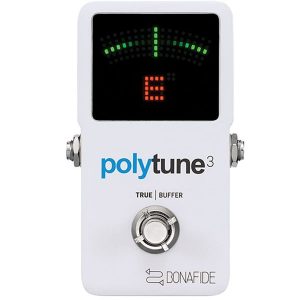 | Type: Polyphonic / monophonic tuner pedal | $100 | Read Full Review Below |
| 2. Donner DT-1 Chromatic tuner pedal (Best Cheap) | 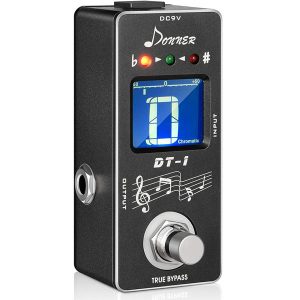 | Type: Chromatic tuner pedal | $30 | Read Full Review Below |
| 3. Peterson StroboStomp HD (Editor's Choice) | 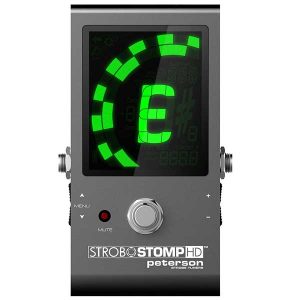 | Type: Strobe tuner pedal | $140 | Read Full Review Below |
| 4. Ibanez BigMini Chromatic Tuner Pedal | 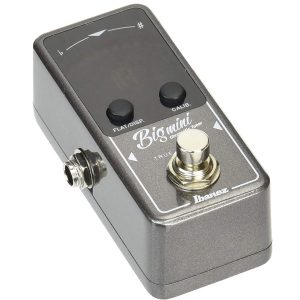 | Type: Chromatic tuner pedal | $50 | Read Full Review Below |
| 5. Boss TU-3 Chromatic Tuner | 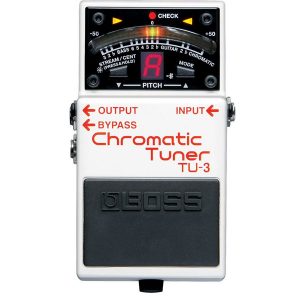 | Type: Chromatic tuner pedal | $100 | Read Full Review Below |
| 6. Korg Pitchblack Advance Chromatic Tuner | 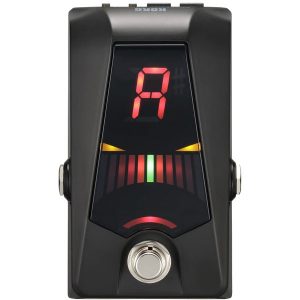 | Type: Chromatic tuner pedal | $80 | Read Full Review Below |
| 7. Behringer TU300 Chromatic Tuner Pedal | 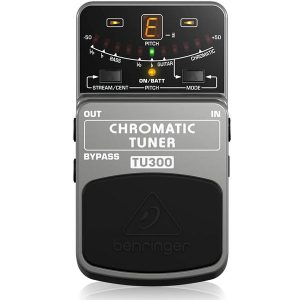 | Type: Chromatic tuner pedal | $35 | Read Full Review Below |
| 8. GuitarX X9 Chromatic Tuner Pedal | 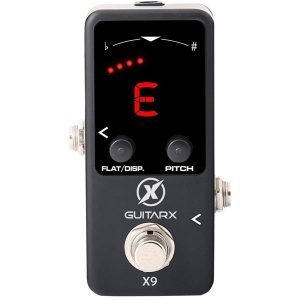 | Type: Chromatic tuner pedal | $30 | Read Full Review Below |
| 9. Monoprice 611220 Chromatic Tuner Pedal | 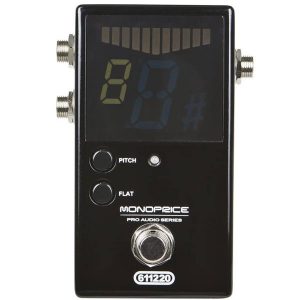 | Type: Chromatic tuner pedal | $25 | Read Full Review Below |
| 10. Valeton CTU-1 Coral Tuner | 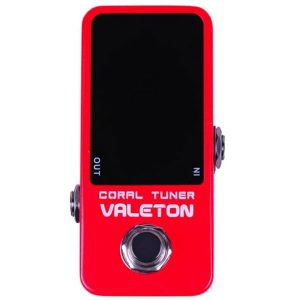 | Type: Chromatic tuner pedal | $40 | Read Full Review Below |
| 11. KLIQ TinyTune Chromatic Tuner | 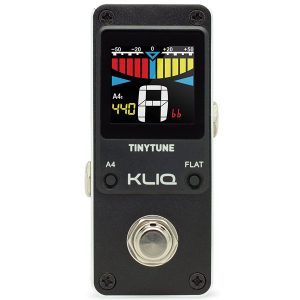 | Type: Chromatic tuner pedal | $30 | Read Full Review Below |
| 12. JOYO JF-18 Power Tune Chromatic Tuner and Power Bank | 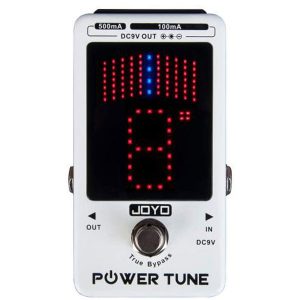 | Type: Chromatic tuner pedal | $90 | Read Full Review Below |
| 13. The GOGO Chromatic Tuner Pedal | 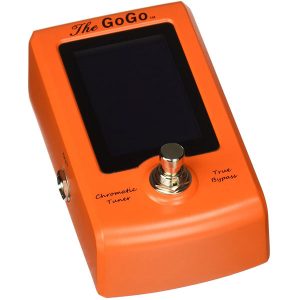 | Type: Chromatic tuner pedal | $70 | Read Full Review Below |
Here Are the Best Bass Tuner Pedals
1. TC Electronic PolyTune 3 (Best Overall)
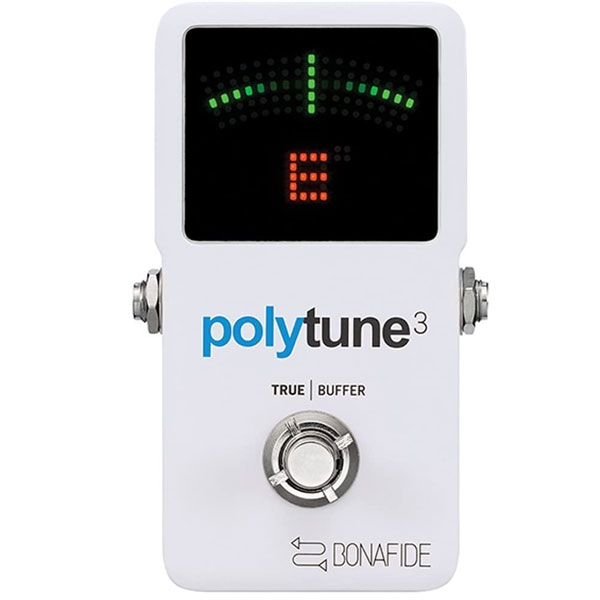
| Estimated Price | $100 |
| Type | Polyphonic / monophonic tuner pedal |
| Accuracy | +/- 0.5 percent chromatic mode, +/- 0.02 percent strobe mode |
| I/O | 1x¼” input, 1x¼” output, 9V Power output, micro USB port |
| Power | 100mA@9V PSU or 9V battery |
My Review: The TC Electronic Polytune 3! When you see a touring musician’s pedalboard, chances are the Polytune is first in line. Danish pedal maker, TC Electronic has been putting out some mighty fine pedals in the last decade and the Polytune line is their uncontested bestseller.
The Polytune revolutionized the way we tune our guitars back in 2010 when it first arrived, with its solid design, compact form factor, bright display, and of course as the name suggests the polyphonic mode which lets you strum all the strings on your guitar at once, then you tune and then you rock. But the Polytune 3 is even better, it switches automatically between the polyphonic and monophonic modes based on how many strings you play. If you are looking for tuning accuracy then the strobe mode is the one for you, with a +/- 0.02 percent accuracy, while the chromatic mode lets you tune within +/-0.5 percent.
They’ve added the Bonafide Buffer circuitry which preserves your signal through long cables and convoluted pedalboards, and you can switch it to True Bypass if you so desire. It even has an ambient light detector that adjusts the super bright 109 LED display for perfect readability in any lighting conditions. It also has an “always-on” mode that doesn’t mute the output while it is switched on, letting you check your tuning while you play and adjust the tuning on-the-fly. The Polytune 3 has a 9V DC output that enables you to power other pedals with a daisy-chain, with a combined power draw of up to 300mA.
Key Specs: The Polytune 3 is a rugged, high-quality polyphonic tuner pedal, that automatically switches between polyphonic and chromatic or strobe modes. It has very good tuning accuracy for the non-polyphonic modes: +/- 0.5 percent for chromatic and +/- 0.02 percent for the strobe mode. It lets you switch between true bypass and buffered bypass through an internal dip-switch. The 109 LED display has a light sensor that adjusts the brightness automatically to suit the lighting conditions, or you can select your preferred brightness setting manually. It can power other pedals from the standard 9V DC output, with a power draw of up to 300mA
Target Customer: The Polytune 3 is a great tuner pedal for the gigging musician. It’s rugged, it looks nice, and it has a full set of features even if you take the poly-mode out of the equation. It’s accurate, the display is bright, it lets you switch between true and buffered bypass modes, and it can power other pedals from the 9V DC output.
Bottom Line: If you are looking for a tuner pedal, the Polytune 3 is the one all others will have to measure up to, it’s just that good. In my opinion, it’s the best bass tuner pedal for the money.
2. Donner DT-1 Chromatic Tuner Pedal (Best Cheap)
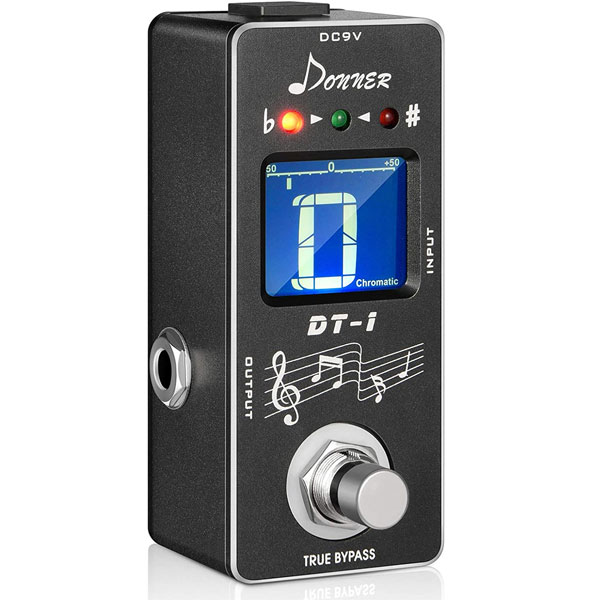
| Estimated Price | $30 |
| Type | Chromatic tuner pedal |
| Accuracy | +/- 1 percent |
| I/O | 1x¼” input, 1x¼” output |
| Power | 90mA@9V PSU or 9V battery |
My Review: Donner has been steadily making a name for itself as a manufacturer of very affordable, and decent quality guitar, and bass pedals. The Donner DT-1 is a super-compact chromatic tuner with a wide enough detection range to cater to both guitars and extended range basses. It features a bright and easy to read display, with an LCD that shows the note you are currently tuned to, as well as the distance you are away from the reference pitch.
The three LEDs light up if your pitch is flat, sharp (red LEDs), or if you are in tune (green LED). Compared to other tuner pedals, it’s feature set is pretty bare-bones, but it does an excellent job at its price point. It just tunes your bass, and that’s it. The chromatic nature of the DT-1 allows for a variety of tuning options, but they’re not as easily accessible as with higher-end tuners. In practice, it performs quite well, the tuning is accurate when compared with other pedal tuners. There will be some minimal variation, but you won’t be able to hear it.
Key Specs: The Donner DT-1 is a sturdy chromatic tuner in a mini-sized metal enclosure. It has a +/-1 percent tuning accuracy which is well below what most of us can distinguish between. It has a bright and easy to read LCD backlit display, that will make tuning easy on the darkest of stages. It draws 90mA of DC power from a standard 9V PSU or a 9V block battery.
Target Customer: The Donner DT-1 is a compact, budget-friendly chromatic tuner pedal. It might not be the best choice for a gigging pro, but if you are looking for a decent tuner with a small footprint that won’t break the bank, this one is on the shortlist.
Bottom Line: This is one of the cheapest tuner pedals on the market, it’s easy to use, has good accuracy, and will suffice in most tuning situations.
3. Peterson StroboStomp HD (Editor’s Choice)
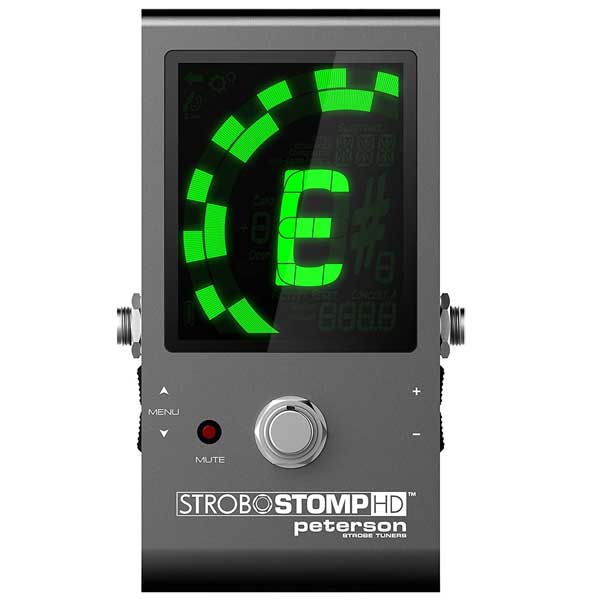
| Estimated Price | $140 |
| Type | Strobe tuner pedal |
| Accuracy | +/- 0.1 percent |
| I/O | 1x¼” input, 1x¼” output, 9V DC output, micro USB port |
| Power | 85mA@9V PSU or 9V battery |
My Review: Peterson has been making pro-grade strobe tuners for the last 70 years, and they’ve earned a stellar reputation for them. But now they’ve built a strobe tuner into a rugged pedal enclosure, and it is extraordinary. The Peterson StroboStomp HD features outstanding tuning accuracy coming in at +/- 0.1 percent and a ridiculously huge LCD with variable color LED backlight – this means that you can personalize the background color for the display.
It has three user-selectable bypass modes: buffered bypass, true bypass, and monitor mode (where the output is not muted, letting you check your tuning while playing). The Strobostomp HD’s strong point is its level of customizability. Besides the standard tuning mode, it offers 135 sweetened tunings, which correct inherent tuning issues with certain instruments. It supports multiple tuning presets – and it even orders them according to your most commonly used ones.
You can assign different display colors to different tuning presets, making custom tunings a breeze. All this functionality might sound like it’s a complicated pedal, but in use, it’s very intuitive. Plugin your instrument, pluck a string, tune until the strobe wheel stops (if it spins clockwise you’re sharp, counterclockwise and you’re flat), and you’re in tune.
Key Specs: The Strobostomp HD is a strobe tuner in a pedal format, housed in a tank-like aluminum enclosure. It features the biggest LCD with LED backlighting found on any pedal tuner, and it’s fully customizable. Its accuracy is rated at +/- 0.1 percent. It has 135 sweetened tuning presets to correct tuning problems encountered with some stringed instruments. It draws 85mA from a 9V PSU or 9V battery and the 9V DC output lets you power other pedals through a daisy chain with a maximum power draw of 1000mA!
Target Customer: The Peterson Strobostomp HD is probably the best tuner pedal on the market today. It is feature-packed and it has unrivaled customization options. If you are serious about tuning your instrument, there’s nothing like it out there.
Bottom Line: If you want elite performance in a tuning pedal then this is the one for you. This is easily one of the best bass guitar tuner pedals out there right now.
4. Ibanez BigMini Chromatic Tuner Pedal
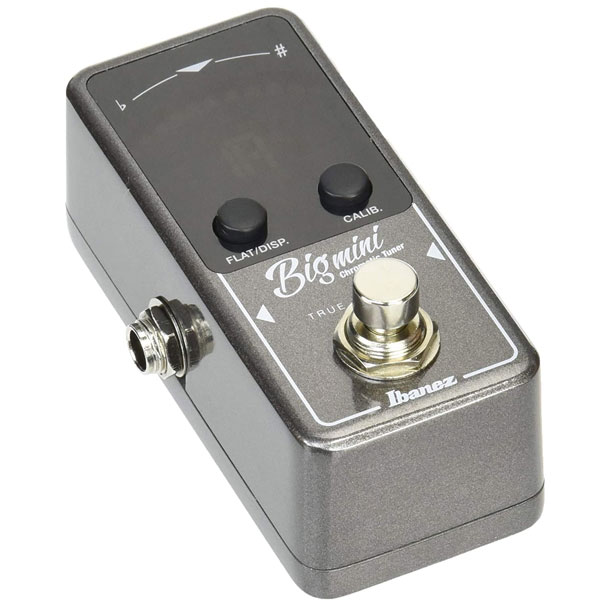
| Estimated Price | $50 |
| Type | Chromatic tuner pedal |
| Accuracy | +/-1 percent |
| I/O | 1x¼” input, 1x¼” output |
| Power | 14mA@9V PSU or 9V battery |
My Review: Ibanez is a long time manufacturer of great quality stompboxes and some legendary ones as well, the Big Mini tuner pedal could fit in somewhere between these two categories. As the name suggests, it’s a super small-sized chromatic tuner pedal with solid build quality, a great price point, and good features.
It is housed in a sturdy aluminum enclosure and it features a bright and big LCD (for the size of the pedal) that displays the current pitch, while the 11 segment LED lets you fine-tune it. The BigMini has two tuning modes, a strobe mode, and a needle mode. It’s not bad from the accuracy standpoint, with +/-1 percent. In practice it’s a straightforward affair: plugin, tune, play.
Key Specs: The BigMini from Ibanez is a small form-factor tuner pedal, housed in a rugged aluminum enclosure. It features two tuning modes: Strobe and Needle. The pedal also has a true bypass circuit, for zero loss of tone while it’s in your signal chain. You can also drop tune your bass by up to four semitones using the “flat” push button on the faceplate. It draws 14mA from a 9V PSU only.
Target Customer: The BigMini is a very competitively priced chromatic tuner with a decent accuracy rating, housed in a small and sturdy enclosure. It might not be the tuner for a gigging bass player, but for all other purposes, it’s a great value pedal.
Bottom Line: If you are low on pedalboard real-estate, and are looking to get a decent tuner that won’t drain your finances, check out the BigMini, it’s a good little pedal.
5. Boss TU-3 Chromatic Tuner
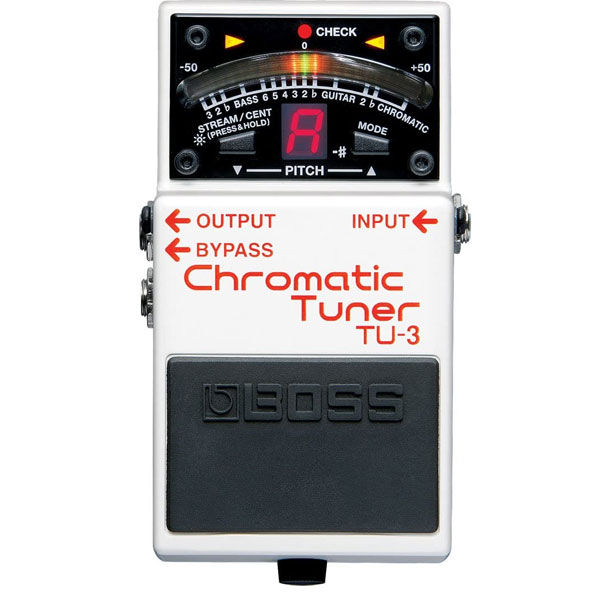
| Estimated Price | $100 |
| Type | Chromatic tuner pedal |
| Accuracy | +/-1 percent |
| I/O | 1x¼” input, 1x¼” output, 9V DC output |
| Power | 85mA@9V PSU or 9V battery |
My Review: This is one of the greats from BOSS, probably the biggest pedal manufacturer out there. The TU-3 is an upgrade to the acclaimed TU-2 which is regarded as the world’s best-selling tuner pedal. The TU-3 is a solid chromatic tuner with an improved display (high brightness mode), being easier to read in bright daylight. The Accu-Pitch function gives you a visual confirmation when you are in tune. The TU-3 has a wide frequency detection range, being able to accommodate extended-range basses and guitars. The Flat-Tuning mode supports up to six half-steps, making drop tuning easy.
The TU-3 has two ¼” outputs: Output mutes the pedal when tuning, while Bypass is unmuted, letting you tune as you play. You can also power a few pedals from it thanks to its 9V DC out.
Key Specs: The Boss TU-3 is the successor of the renowned TU-2, with the same tank-like build and an upgraded feature set. It has a bright 21-segment LED display with a “high brightness mode”, making it easier to read in an outdoor setting. It accommodates extended-range basses as well as guitars. The dual outputs give you the option of tuning silently or with an unmuted output. The TU-3 draws a maximum of 85mA(with high brightness mode) from a 9V PSU or a 9V battery.
The 9V DC output enables you to daisy-chain up to seven Boss-type pedals. It has a buffered bypass mode only, which might displease tone-purists, but it’s a good buffer, and it will prevent signal degradation with long cable runs on bigger stages
Target Customer: The TU-3 is an industry-standard. It doesn’t have all the bells and whistles of other tuners on this list, but it does what it’s supposed to do: tune your bass, and it does it very well.
Bottom Line: If you are looking for a tried-and-tested tuner pedal, that’s built like a tank and doesn’t cost a fortune, take a look at the TU-3.
6. Korg Pitchblack Advance Chromatic Tuner
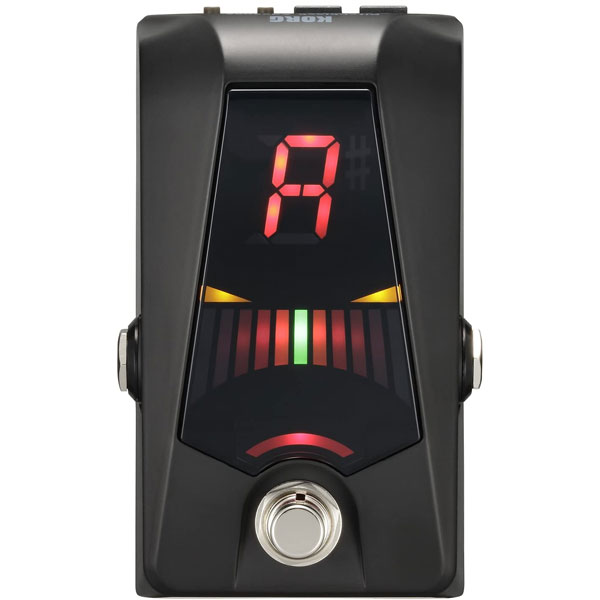
| Estimated Price | $80 |
| Type | Chromatic tuner pedal |
| Accuracy | +/- 0.1 percent |
| I/O | 1x¼” input, 1x¼” output, 9V DC output |
| Power | 20mA@9V PSU or 9V battery |
My Review: The Korg Pitchblack is a standard to which all tuners must compare. With its tank-like construction, big and bright LED display, true bypass, and great tuning accuracy, this little chromatic tuner is really, really hard to beat and it has been for a long time. The Pitchblack Advance is an updated version of the classic now-classic Pitchblack. It offers 4 tuning modes Regular, Strobe, Half-Strobe & Mirror, they all work as expected. The accuracy is very good at +/- 0.1 percent. If you want the best tuning accuracy the Pitchblack Advance has to offer, you will have to use Strobe mode.
One distinguishing feature of the Korg Pitchblack is that it has a 9V DC out from which you can power another pedal with a maximum draw of 200mA, this is enough for most stompboxes and is very useful in relieving clutter on your pedalboard. In practice, the Pitchblack Advance is simple and straightforward to use. The tuning modes are cycled through a button on the front of the pedal, calibration is achieved with the button next to it. The display is very bright and can be easily read even in bright daylight, while tuning is precise and spot-on with all display modes.
Key Specs: The Pitchblack Advance is a rugged chromatic tuner with 4 display modes. It is built into a solid aluminum housing and features a true bypass circuit. It boasts a great accuracy rating with +/- 0.1 percent, and it can be powered either by a 9V block battery or a standard 9V PSU. The Pitchblack Advance comes in four color variations: Black, White, Blue, and Red, letting you visually tailor your pedalboard to your liking. The 9V DC output is rated for 200mA, letting you power a few pedals off of it with a daisy-chain.
Target Customer: The Pitchblack Advance is a rugged and well-built chromatic tuner pedal. It’s minimal in its design but offers great tuning accuracy and four tuning modes. It’s well suited for extended range basses and guitars, and it’s a little cheaper than its competition.
Bottom Line: If you are looking for a rugged tuner that will withstand constant gigging and abuse, has great tuning accuracy, and gives you the option to match colors with the rest of your gear, while being quite affordable when compared to its competition, the Pitchblack Advance could tick all of these boxes for you.
7. Behringer TU300 Chromatic Tuner Pedal
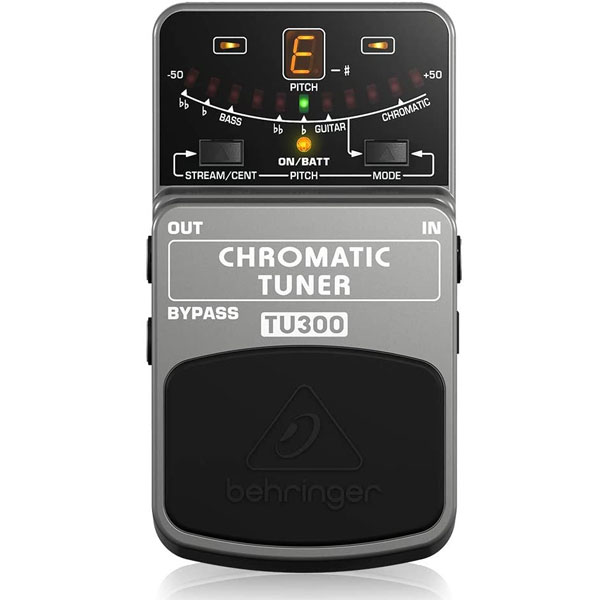
| Estimated Price | $35 |
| Type | Chromatic tuner pedal |
| Accuracy | +/- 1.5 percent |
| I/O | 1x¼” input, 1x¼” output |
| Power | 70mA@9V PSU or 9V battery |
My Review: If you’re out looking for an affordable tuner pedal with some cool features, you will have some trouble beating the Behringer TU300 outside of the used market. Behringer has a very comprehensive budget pedal lineup and this is one of them. It’s made from the standard Behringer hard plastic enclosure and it offers 4 tuning modes for bass: regular – the standard E tuning, flat – this tunes your bass a half step down, double flat – this will tune your bass a whole step down from standard and chromatic mode which is the only one you should care about. The TU300 is slightly less accurate than other flagship tuners with +/-1.5 percent, but it will tune your bass or guitar nicely.
Key Specs: The Behringer TU300 is a budget chromatic tuner pedal housed in a hard plastic enclosure. It features 7 tuning modes: 3 for guitar, 3 for bass plus the chromatic mode, which is the only one you will probably use. The tuning accuracy is not bad at +/- 1.5 percent, but it’s one of the least accurate tuners on this list (on paper at least). It only has a buffered bypass, but it is decent. It draws 70mA from a standard 9V PSU or a 9V block battery.
Target Customer: The TU300 is not intended as a main gigging bass tuner, but something that you throw in your gig bag as a backup if your main tuner dies on you. It’s not a bad tuner, but for a few bucks more, you can get a better built, more accurate unit. It’s great for its price as a chromatic tuner for at-home use or as a backup.
Bottom Line: If you want a backup chromatic tuner, and are short on funds, check out the TU300.
8. GuitarX X9 Chromatic Tuner Pedal
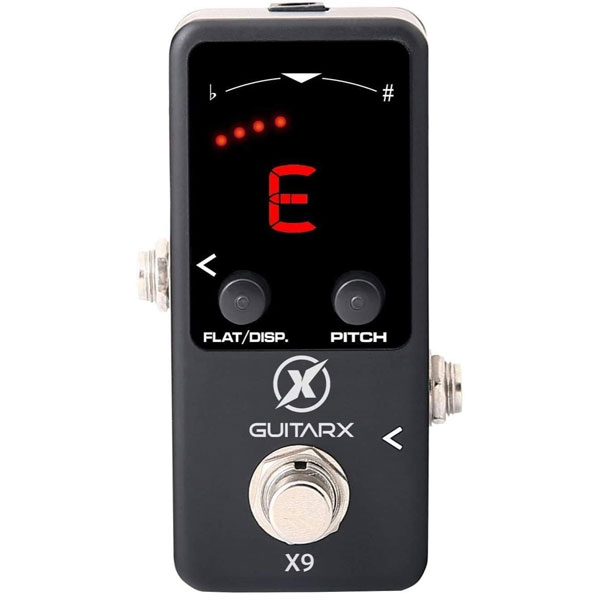
| Estimated Price | $30 |
| Type | Chromatic tuner pedal |
| Accuracy | +/- 0.5 percent |
| I/O | 1x¼” input, 1x¼” output |
| Power | 40mA@9V PSU only |
My Review: The X9 chromatic tuner is one of the best budget tuner offerings available today. It ticks all the right boxes: it has a very compact form-factor, it has good tuning accuracy at +/- 0.5 percent, it is solidly built, and it has a bright and easy-to-read display. The frequency detection range is wide enough for it to include the low B string of extended-range basses as well as guitars. The display features an LCD that shows your current pitch, while the 9 LEDs let you finely adjust it until you’re in tune. The layout is simple and intuitive to use, with a true-bypass footswitch, and two buttons to choose your reference pitch ( between 435Hz and 450Hz), and your choice of drop tunings with up to 4 semitones below the standard pitch. Using the X9 is as simple as can be: plugin, tune, rock. While the tuner is engaged, your output will be muted, letting you tune in silence – a must-have in live situations.
Key Specs: The X9 is a small form-factor chromatic tuner built into a solid aluminum enclosure. It features a bright red LCD, with an additional 9 LEDs for fine-tuning and a true bypass circuit. The reference pitch can be adjusted between 435Hz and 450Hz, and you can tune your instrument flat by up to 4 semitones. The X9 draws 40mA from a standard 9V PSU only.
Target Customer: The GuitarX X9 is probably one of the best budget tuners around today. It’s very affordable, but it offers solid performance, with good build quality, its small form-factor, and very good tuning accuracy among its peers.
Bottom Line: If you are in the market for a small chromatic tuner that’s easy to use, accurate, and costs less than a good set of bass strings, check out the GuitarX X9, it’s very good.
9. Monoprice 611220 Chromatic Tuner Pedal
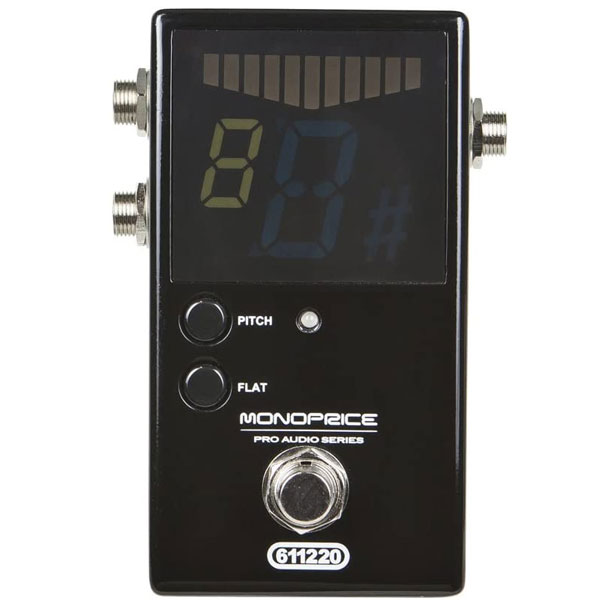
| Estimated Price | $25 |
| Type | Chromatic tuner pedal |
| Accuracy | +/- 1 percent |
| I/O | 1x¼” input, 1x¼” output |
| Power | 40mA@9V PSU or 9V battery |
My Review: Monoprice is one of those guitar pedal brands that gets sold under a plethora of brand names, most often with increased asking prices (like Modtone charging double for the same pedal). The Monoprice 611220 Chromatic tuner looks like a mix between the Korg Pitchblack and the Boss TU-3. The 11 LED display is reminiscent of the Korg design, while its form-factor, boxy styling, and two outputs resemble the TU-3. The pedal seems well built and is housed in a rugged aluminum enclosure. The display is big and bright making it easy to read even in daylight. The tuning accuracy is decent, with +/-1 percent.
It’s rather on the low accuracy side of the list, but it does its job well enough. Its frequency detection range is wide enough to cater to extended-range basses and guitars. The Monoprice chromatic tuner features two output options: the first one is a true bypass output that gets muted when the pedal is in tuning mode, the second one lets you tune on-the-fly while playing (without muting the output). It also lets you choose a reference frequency between 436Hz and 445Hz – great for playing with acoustic instruments that are not easily tuned, like a piano. The tuner is very responsive and fast, with minimal lag between plucking the string and the readout.
Key Specs: The Monoprice 611220 is a well-built chromatic tuner, with a sleek aesthetic and basic functions. It features a bright 11 LED display for fine-tuning and an LCD that shows your current pitch. Its tuning accuracy is decent coming in at +/- 1 percent. The pedal has a true bypass circuit connected to the muted output, while the unmuted output is buffered. It also lets you tune flat by up to 3 semitones. It can run on either a 9V battery or a standard 9V PSU.
Target Customer: The Monoprice 611220 chromatic tuner is a budget pedal that brings a lot to the table: good build-quality, a bright display, a true bypass circuit, at a very low price point.
Bottom Line: If you are looking for a good and very affordable tuner pedal, give this one a try.
10. Valeton CTU-1 Coral Tuner
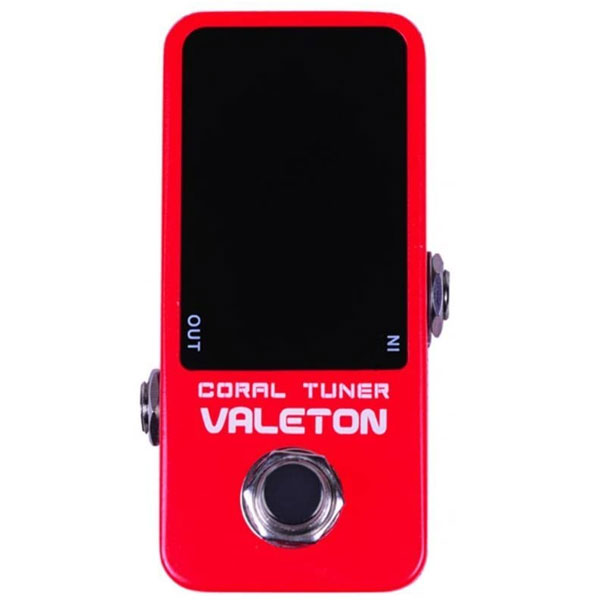
| Estimated Price | $40 |
| Type | Chromatic tuner pedal |
| Accuracy | +/-2 percent |
| I/O | 1x¼” input, 1x¼” output |
| Power | 60mA@9V PSU or 9V battery |
My Review: Valeton is a US-based manufacturer that has made a name for itself by building hardware for other companies. In recent years they’ve also started to offer the gear they built for others under their own brand name. The CTU-1 is a chromatic tuner housed in a “mini-sized” aluminum enclosure, with a coral-red finish. It features a very big and bright display (about 60% of the surface area of the pedal), making it easy to read in any lighting conditions. The CTU-1’s accuracy is decent with +/-2 percent – it’s not great when compared to its peers, but it’s still under the human ear’s perception range. It has a true bypass footswitch for minimal loss of tone while the pedal is not in use. Its wide frequency spectrum makes it well suited for extended-range basses and guitars. In use, the CTU-1 is fast and responsive; when compared to more precise tuners, the differences in accuracy are negligible.
Key Specs: The CTU-1 is a small form-factor chromatic tuner housed in a coral red-painted aluminum enclosure. It features a large (for its size) LED display that makes it easy to read in any lighting conditions. The pedal has a +/-2 percent tuning accuracy and a true bypass circuit. It draws 60mA of power from a standard 9V PSU, battery operation is not available due to its compact size.
Target Customer: The CTU-1 is a great back-up tuner, or a good choice if you are short on pedal-board real-estate. It has a great display and has an affordable price tag. It won’t be accurate enough for a pro, but it’s a great option for everyone else.
Bottom Line: If you are looking for a good budget tuner pedal to have in your gig bag, or as a backup to your main tuner, try out the CTU-1 from Valeton, it’s certainly better than a clip-on headstock tuner.
11. KLIQ TinyTune Chromatic Tuner
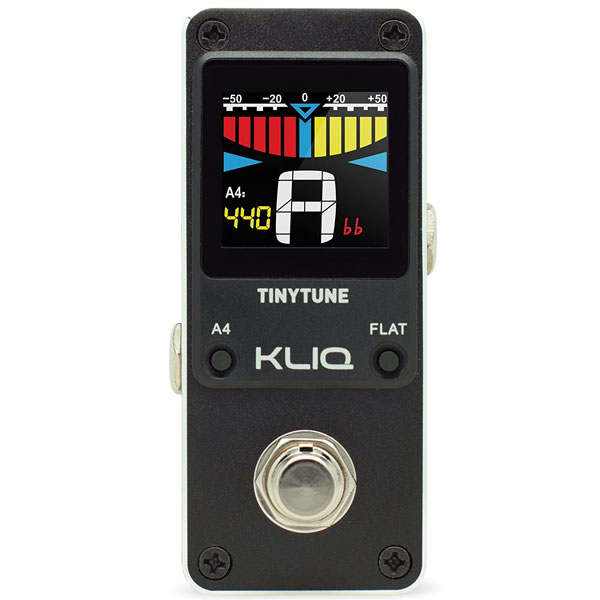
| Estimated Price | $30 |
| Type | Chromatic tuner pedal |
| Accuracy | +/- 0.5 percent |
| I/O | 1x¼” input, 1x¼” output |
| Power | 24mA@9V PSU or 9V battery |
My Review: KLIQ is a little-known company that was created out of necessity and is now making a name for itself offering good quality guitar tuners and accessories. The company was formed by a musician, frustrated with the quality of available tuners, and has set out to make his own, better ones, at more affordable prices. The TinyTune is a pedal-format version of the company’s first tuner: the UberTuner clip-on guitar tuner.
The TinyTune is a mini-sized chromatic tuner housed in an aluminum chassis. It features a bright and colorful LED display, making it easy to see in most lighting conditions. It has good tuning accuracy with +/- 0.5 percent. There are no hidden functions, what you see is what you get. It has a true bypass footswitch that prevents tone degradation while the pedal is off. Switching it on will mute the output jack for silent tuning.
The TinyTune works well with extended-range basses and guitars due to its wide frequency detection range. On the faceplate, there are two pushbuttons: the one on the right lets you tune flat by up to 4 semitones below the standard pitch, while the left push-button enables the calibration of your desired reference frequency between 430Hz and 450Hz. The TinyTune is fast and responsive in use.
Key Specs: The KLIQ TinyTune is a good quality small form-factor chromatic tuner pedal. It features a bright and colorful LED display, with excellent visibility in any lighting conditions. It has a true bypass footswitch, ensuring minimal loss of your tone while the pedal is off. The Flat button lets you tune your instrument up to four semitones below the standard pitch. The reference pitch is selectable in 1Hz increments from a range between 430Hz and 450Hz. It draws a maximum of 24mA from a standard 9V PSU while tuning, it does not support battery operation.
Target Customer: The TinyTune is one of the best budget mini-tuners around. It has good tuning accuracy, and it’s super small footprint makes it easy to fit on the most crowded pedalboards. It’s a great tuner for any musician, gigging pro or otherwise.
Bottom Line: If you are searching for a ruggedly built, small form-factor tuner, that is very easy to use, that will comfortably fit anywhere, and doesn’t cost an arm and a leg, the TinyTune from KLIQ might just be it.
12. JOYO JF-18 Power Tune Chromatic Tuner and Power Bank
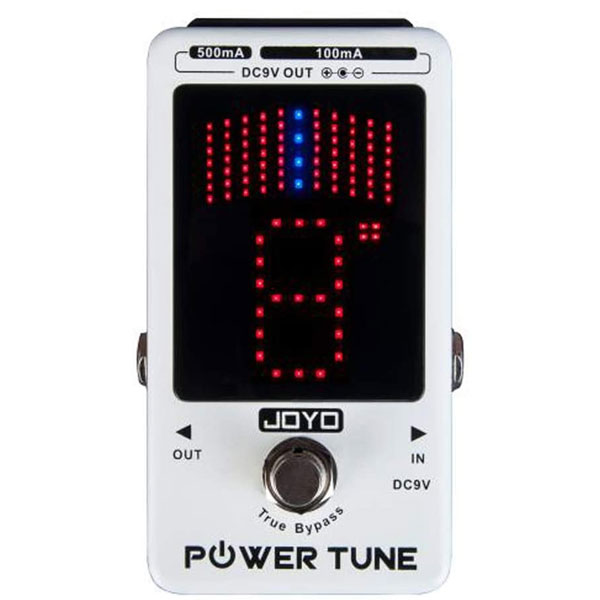
| Estimated Price | $90 |
| Type | Chromatic tuner pedal |
| Accuracy | +/- 1 percent |
| I/O | 1x¼” input, 1x¼” output, 8x 9V DC outputs |
| Power | 120mA@9V PSU |
My Review: The JOYO JF-18 Power Tune is somewhat of an oddball among tuner pedals. While a good percentage of the full-sized pedals on our list let you power a few low-draw pedals off of their 9V DC output, the JOYO JF-18 Power Tune takes this concept to the extreme. Not only is it a good chromatic tuner, with a bright LED display and a wide frequency detection range, but it also functions as a true power bank with 8 isolated 9V DC outputs totaling 1600mA.
The tuner side of things is as expected: a bright LED screen offering great visibility in any lighting conditions, a fast and precise tuning experience with +/- 1 percent accuracy, topped off by a true bypass footswitch that prevents the loss of your signal while the pedal is switched off. The power section, however, is unexpected, to say the least. The front of the pedal features 8 filtered, low noise outputs with short circuit and overcurrent protection. Six of the outputs give you 100mA of power suitable for most standard analog pedals, while the other two outputs have a power rating of 500mA each, which will be able to cover even the most demanding digital effects pedals as well.
There is no need to worry about your signal running through the power supply, JOYO has made sure that there is no crosstalk, noise or hum, affecting your pristine tone. The switching adapter does not get hot like many other power supplies. The Power Tune comes with its own power adapter that delivers 2A to the pedal, but if you want to just power the tuner, you can use a standard 9V PSU that delivers 120mA. The Power Tune also comes with 8 standard DC power cords, and two polarity reversing cables in the box.
Key Specs: The JOYO JF-18 Power Tune is a very well-built chromatic tuner pedal that also functions as a power bank. The tuner features a bright LED display that is easy to read in the most demanding lighting conditions. The tuning accuracy is good enough for moderately demanding musicians with a respectable +/- 1 percent sensitivity. The pedal has a true bypass circuit that mutes the output of the pedal when it is engaged. The tuner draws 120mA of power from any standard 9V PSU with the required rating, but if you want to use the power bank features you will have to use the included 2A adapter. With its adapter, it offers 8x9V DC outputs: 6x100mA and 2x500mA. Also included are all the DC cables you’ll need to power your pedalboard.
Target Customer: The JOYO JF-18 is a good tuner, but its power bank capability makes it an astounding dual purpose pedal with a very low noise floor. It has all the accessories you could wish for, and for its price tag (that’s lower than some of the tuners on our list) you get an included power brick.
Bottom Line: If you are thinking of building a small to medium-sized pedalboard, take a look at the JOYO JF-18 Power Tune, it might save you a good chunk of cash while getting a decent tuner pedal for free.
13. The GOGO Chromatic Tuner Pedal
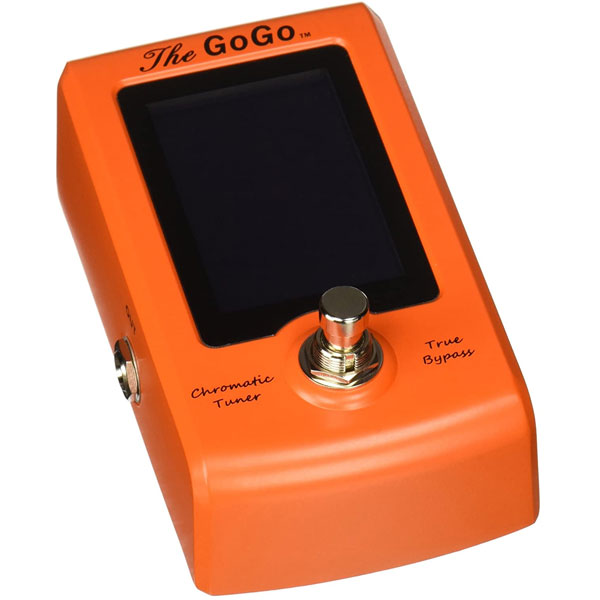
| Estimated Price | $70 |
| Type | Chromatic tuner pedal |
| Accuracy | +/- 0.5 percent |
| I/O | x¼” input, 1x¼” output, 9V DC output |
| Power | 24mA@9V PSU or 9V battery |
My Review: GOGO Tuners is a manufacturer that specializes in tuners (it’s in their name), and the GOGO Chromatic tuner pedal combines all that expertise into a single pedal. This pedal’s most striking feature is its huge LCD screen, and it is one that sets it apart from its competition. The bright LCD takes up 70 to 80% of the available real-estate on the top of the pedal. It seems that visibility is paramount to this design.
The rugged aluminum enclosure is painted bright orange and the pedal feels very well-built. It has a true bypass circuit that ensures the integrity of your signal when the pedal is not in use. The tuning accuracy is also very good, with +/- 0.5 percent sensitivity. The GOGO Chromatic tuner is one of the simplest pedals on the market, it has no adjustable reference pitch, no drop tuning options, no bells or whistles, just a big screen, and an accurate chromatic tuner.
The frequency detection range is wide enough to accommodate extended-range basses and guitars. As you plug in your instrument and press the footswitch, it will quickly start responding to whatever you play and show you whether your notes are sharp or flat. The screen will visualize everything perfectly, as it can be seen even from far away. While tuning, the color scheme will stay red, when you are in tune it turns green. The tuning is fast, accurate, and responsive when compared to its peers. It also has a 9V DC output that lets you power a few pedals through the use of a daisy-chain.
Key Specs: The GOGO Chromatic tuner is a high-quality pedal with a large LCD screen that lets you easily read it in any lighting conditions, and from farther away than with most other tuners on the market. It is built like a bright orange tank and features +/-0.5 percent accuracy. The true bypass footswitch ensures the integrity of your signal when the pedal is off. It can power other pedals from its 9V DC out. The GOGO Chromatic tuner draws 24mA either from a standard 9V DC power supply or a 9V block battery.
Target Customer: The GOGO Chromatic Tuner is a type of pedal that won’t require any manuals and instructions to be figured out, making it ideal for musicians of all experience levels.
Bottom Line: If you’re looking for a well-built, simple to use, and accurate tuner pedal, that just does its job from the get-go and doesn’t break the bank, take a look at the GOGO Chromatic Tuner Pedal, you won’t be disappointed.
Choosing the Right Tuner Pedal for Bass Guitars (Buying Guide)
A tuner pedal is probably one of the most useful accessories you will ever buy. If you get a tuner and forget about it, that means that it does its job as it should.
Why Do You Need a Tuner Pedal?
There are lots of options for tuning your bass, from expensive studio-grade rack-mounted tuners to free Apps, clip-on tuners, tuning whistles, tuning forks, etc.
If you are mostly playing at home, a clip-on tuner or a decent tuning App will do just fine. But if you’re a gigging musician or if you are playing in a band, a clip-on will just be an annoyance as they detect the vibrations in the headstock of your bass, they will give false readings if you try to tune in a noisy environment.
A pedal tuner will do its job even during a gig, where asking your bandmates to stop playing so you can tune your bass would be a no-no.
What to look for when buying a tuner pedal?
As you are looking to buy a stompbox, expect to stomp on it quite a few times so construction is an important factor for most bass players out there. The majority of pedals are built using a sturdy aluminum enclosure, but not all, some use plastic enclosures for their effects (looking at you, Behringer!). The Footswitches are generally of decent quality and rarely fail from normal stomping use.
Tuning Modes
Most tuners offer a plethora of displaying tuning modes, from chromatic – showing you the exact note you are playing on the chromatic scale, to strobe mode (which is not a true strobe tuner, just a strobe-like display) that lets you see how far off you are from a particular reference note with the help of a needle, and every colorful display variant in between. Just find the one you like and get on with tuning your bass.
If you are a bassist who likes acrobatic moves on stage or to experiment with different tunings then you are in luck. The latest addition to a basically stagnant pedal is the polyphonic capability, this mode makes it possible for a bass or guitar player (there are no special bass guitar tuners) to strum all the strings at once and check which ones are out of tune with a single glance. Light-emitting diodes or LEDs will light up on the display showing which strings need adjusting. This can be very useful during gigs when you don’t want to spend your time checking if you are in tune. The downside is slightly reduced accuracy and a pricier pedal, so if you are on a budget you can skip the “polytuners” and get a regular old tuner. It will still do the job quite nicely and you will have some cash left over to invest in another pedal that really makes a difference to your tone.
True Bypass vs Buffered Bypass
When you are adding a pedal to your signal chain, preserving your tone is LAW. The discussion here is True bypass vs. Buffered bypass and there are a lot of opinions on the subject. A True bypass sometimes called “hard bypass” disconnects the electronics of the pedal and connects your input and output jacks together, bypassing the pedal and running the signal straight through, in theory without altering your tone. This means that if your pedal loses its power source, the signal will still reach your amp, though slightly degraded. Buffered bypass is a solution to signal degradation which occurs when the signal from your bass passes through the cables and pedals to your amp.
This degradation is largely reduced when using active pickups or electronics in your bass, but it is worsened the more pedals you add to your signal chain. In some cases, as with large pedalboards, a buffered bypass is a good way to preserve the tone of your instrument. It really all depends on the case in point: the type of bass and electronics inside of it, the length of your cables, and how many pedals you run the signal through until it reaches the amp. If you’re running your signal through a large pedalboard it is recommended that the first and last pedal is a “Buffer”.
Some tuners let you choose between True bypass and Buffered bypass which is a nice choice to have since the tuner should be the first pedal in your signal chain.
Tuning Accuracy
The precision of a tuner is measured in percentile form. A percent represents one-hundredth of a semitone. It is commonly agreed upon that the human ear can perceive a change of five percent. Pedal tuners have an accuracy of +/-1 percent at the least, this means that you shouldn’t worry too much about precision.
In recent years pedal makers have been offering “mini” versions of their standard stompbox-sized tuner pedals. If you are running low on pedalboard real estate or if you just need a small tuner to throw in your gig bag, one of these minis might be a good idea.
When you are playing in a band with an acoustic instrument like a piano, that is not tuned to the standard 440Hz, being able to shift the reference frequency is a prerequisite. To aid in this scenario, worthwhile tuners let you choose the reference point from a range below and above 440Hz.
Display
A big, bright, and easy to read LED display is a must-have for a good tuner pedal since you will probably have to tune your bass on a dark stage at some point in time. Manufacturers of tuner pedals are always trying to innovate in this regard, offering all kinds of colorful displays, just find one that you are comfortable with and stick with it.
Bass tuners
As we all know, basses produce lower frequencies than a guitar would. While there are no bass-specific tuners on the market, you should make sure that the tuner you are buying can correctly detect the low frequencies of your bass. There are tuners out there that struggle to nail down the low B string of a 5-string bass, some even failing with the E string.
Features
NOBODY should hear you while you tune your instrument; not your bandmates and especially not your audience, so tuning while the output is muted is something every tuner should have! If the tuner you are looking to buy doesn’t have this feature, better give it a pass – most have it though.
Some pedal tuners give you the option of powering other pedals through your tuner by daisy-chaining. This feature can be very useful if your power-brick doesn’t have enough outputs for all your pedals.
Tips
Sometimes, a bad quality cable will influence the tuning performance of your tuner pedal, this is less the case with guitars, as it mostly concerns the low B string of extended-range basses. In the case of a poor quality cable, your read-out can be unstable, jumping around by as much as a semitone. Just get a decent cable from your bass to the tuner and you should be just fine.
Tuner Terminology
Chromatic Tuner: This means that the tuner will only identify one of the 12 notes of the chromatic scale used in western music. It’s the most basic tuning mode found on the majority of tune pedals.
Polyphonic Tuner: Lets you strum all the strings on your instrument, enabling you to quickly assess if you are in tune and easily correct offenders. It comes with the drawback of lower tuning accuracy.
Strobe Tuners: They are the most accurate tuners of all, generally very expensive and usually reserved for rack-mounted units, employed by sound engineers in studios or live situations.

My name is Chris and I’ve had a passion for music and guitars for as long as I can remember. I started this website with some of my friends who are musicians, music teachers, gear heads, and music enthusiasts so we could provide high-quality guitar and music-related content.
I’ve been playing guitar since I was 13 years old and am an avid collector. Amps, pedals, guitars, bass, drums, microphones, studio, and recording gear, I love it all.
I was born and raised in Western Pennsylvania. My background is in Electrical Engineering, earning a Bachelor’s degree from Youngstown State University. With my engineering experience, I’ve developed as a designer of guitar amplifiers and effects. A true passion of mine, I’ve designed, built, and repaired a wide range of guitar amps and electronics. Here at the Guitar Lobby, our aim is to share our passion for Music and gear with the rest of the music community.

I’m a bass player and I’ve been using a tuner pedal for a while now. I’ve tried a lot of different ones, but the one I like the best is the Boss TU-2. It’s easy to use.